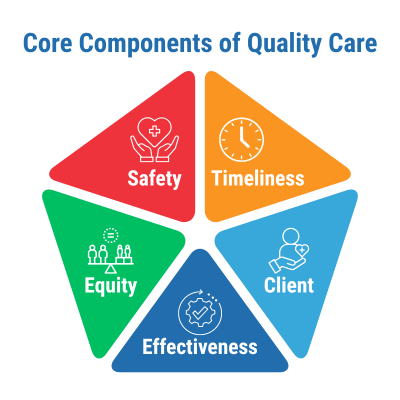Improve quality of care in personal care services with proven strategies for caregiver training, communication, technology, and client satisfaction.
Introduction
Personal care services (PCS) provide support for individuals who need help with daily tasks such as bathing, essential household chores, grooming, and recovering from illness or injury. When service quality falls short, it can lead to poor client outcomes, staff turnover, and compliance risks.
Many home care agencies struggle to maintain consistent high-quality care for several operational reasons. To deliver safer, more effective client-centered care, agencies must explore better training strategies, adoption of home care software, efficient communication, and real-time monitoring helping agencies deliver safer, more effective, and client-centered care.
What Defines Quality in Personal Care Services?
In personal care services (PCS), quality of care goes beyond completing daily tasks. It involves delivering safe, respectful, and person-centered support that meets each client’s unique needs. According to the Centers for Medicare & Medicaid Services (CMS), high-quality care is defined by its ability to achieve desired health outcomes while aligning with professional standards and client preferences. The core components of quality care are:
Safety – Minimizing risks such as falls, injuries, or infections during care.
Effectiveness – Ensuring services are predicated on evidence-based practices and delivered as intended.
Timeliness – Providing care when it is needed, without unnecessary delays or missed visits.
Client-Centeredness – Respecting client choices, dignity, culture, and preferences in the care plan.
Equity – Delivering consistent care regardless of a client’s background, language, or location.
To evaluate the quality of the personal care services they deliver, agencies often track key performance indicators (KPIs) such as caregiver punctuality, visit completion, client incident reports, and adherence to care plans. Client satisfaction surveys also provide insight into how well services meet expectations.
Common Challenges in Maintaining High-Quality PCS
Delivering high-quality care in PCS demands a consistent, well-coordinated effort across staff, systems, and processes. Unfortunately, many agencies face operational challenges that can compromise care quality and client satisfaction. Addressing these challenges is essential to sustaining high-quality personal care services.
Staff Shortages and High Turnover
When caregiver turnover is high, continuity of care suffers, and clients feel unsettled by changing faces and routines. This can negatively affect client trust and outcomes.
Inconsistent Training and Skill Gaps
Without standardized onboarding and ongoing education, caregivers may lack the competencies needed to provide effective support, especially for clients with complex needs.
Communication Breakdowns
Poor communication between caregivers, coordinators, and families often result in missed updates, delays in care plan adjustments, and confusion over responsibilities. These gaps can lead to duplicative tasks or missed care altogether.
Documentation Errors and Missed Visits
Whether caused by manual errors or lack of oversight, these issues can impact billing, compliance, and client safety.
Low Client Engagement
Without regular input from clients and families, it is difficult to align services with expectations or track satisfaction over time.
Strategies to Improve Quality of Care
Improving the quality of care in PCS requires a multi-faceted approach that blends people, process, and technology. Below are proven personal care best practices to enhance care outcomes, client satisfaction, and agency performance.
Hire and Retain Qualified Caregivers
A solid foundation begins with the right people. Agencies must adopt rigorous hiring standards to ensure caregivers have the necessary skills, experience, and temperament for personal care roles. Pre-employment screenings, background checks, and behavioral assessments are essential in identifying reliable candidates.
Once hired, ongoing training and certification are key to maintaining lofty standards. Certification programs and continuing education help caregivers stay updated with the best practices and evolving care needs. Career development and recognition programs can also reduce turnover by helping caregivers feel valued, motivated, and supported in their roles.
Improve Care Coordination and Communication
Breakdowns in communication can compromise client safety and satisfaction. Agencies must prioritize clear care planning, shift handovers, and regular family communication to ensure everyone involved is informed and aligned.
Adopting CareVoyant home care software helps standardize workflows and improve care coordination. Features such as centralized care plans, real-time updates, task tracking, and alerts reduce errors and promote care continuity.
Monitor and Evaluate Care Delivery
To deliver consistently high-quality PCS, agencies must measure what matters. Client feedback surveys provide insights into client satisfaction and identify areas for improvement. Field supervision and in-home audits help validate the care being delivered and ensure adherence to the care plan.
Tracking Key Performance Indicators (KPIs) such as visit completion rates, caregiver punctuality, missed care alerts, incident frequency, and satisfaction scores enables data-driven decisions. CareVoyant offers an in-depth overview of essential home care KPIs that help measure clinical quality and client experience.
Leverage Personal Care Software
Personal Care Software is a game changer in modernizing PCS and improving efficiency. Electronic Visit Verification (EVV) ensures that every visit is accurately logged, helping prevent fraud and improving accountability. CareVoyant’s EVV software integrates with state systems and supports real-time visit tracking and caregiver verification via mobile devices.
Mobile tools also enable real-time documentation, alerts, and schedule updates. CareVoyant’s clinical and point-of-care features streamline charting, medication reminders, and shift notes, ensuring that caregivers have the information they need at the point of care. GPS tracking and automated alerts for missed visits further ensure timely service delivery and allow agencies to respond promptly to scheduling issues.
Building a Culture of Quality and Compassion
Sustainable improvement comes from within. Agencies must empower caregivers to speak up about challenges, suggest improvements, and report concerns without fear of retaliation. When caregivers are part of the solution, they are more engaged and committed to excellence.
Leadership must set the tone by modeling a commitment to quality, investing in caregiver development, and regularly reviewing performance data. Recognition programs and bonuses for high-performing caregivers reinforce positive behaviors and improve retention, both of which are critical to improving home care quality over time.
Conclusion
Improving care quality in personal care services requires a strategic, client-centered approach that prioritizes people, process, and technology. From hiring and retaining qualified caregivers to implementing comprehensive training programs, improving communication, and actively monitoring care delivery, each strategy plays a vital role in ensuring consistent, high-quality outcomes.
Investing in personal care software is essential. Solutions like electronic visit verification, mobile documentation, and integrated care coordination streamline operations and enhance both caregiver efficiency and client safety.
By embracing these strategies and making data-driven decisions, agencies can elevate their care delivery, strengthen their reputation, and most importantly, improve the lives of those they serve.
Frequently Asked Questions
-
In personal care services, quality of care means delivering safe, effective, timely, and client-centered support that meets each individual’s needs while adhering to professional standards. It ensures better outcomes, higher satisfaction, and regulatory compliance.
-
Consistent caregiver training improves the quality of personal care services by ensuring staff have the skills, knowledge, and confidence to deliver safe, respectful, and effective care tailored to each client’s unique needs.
-
The best ways to improve caregiver retention include offering competitive pay, recognition programs, career advancement opportunities, ongoing professional development, and a supportive work environment that values staff contributions.
-
Better communication between caregivers, coordinators, clients, and families prevents errors, ensures care plan accuracy, reduces missed visits, and strengthens trust between all parties.
-
Home care software improves personal care service quality by streamlining scheduling, enabling real-time updates, tracking visits, ensuring EVV compliance, and improving coordination between care team members.
-
Top KPIs for measuring quality in personal care services include caregiver punctuality, visit completion rates, client satisfaction scores, incident frequency, and adherence to care plans.
-
Electronic Visit Verification (EVV) is important because it ensures accurate visit tracking, prevents billing errors, supports compliance with state requirements, and enables agencies to quickly respond to missed or late visits.
-
The biggest challenges in maintaining high-quality personal care include high staff turnover, inconsistent training, communication gaps, documentation errors, and low client engagement.
-
Client feedback through regular surveys helps agencies understand satisfaction levels, identify service gaps, and make changes that align with client expectations and improve care quality.
-
Strategies to build a culture of quality and compassion include encouraging caregiver input, recognizing high performance, providing leadership support, investing in training, and using performance data to guide improvements.
About CareVoyant
CareVoyant is a leading provider of cloud-based integrated enterprise-scale home health care software that can support all home-based services under ONE Software, ONE Patient, and ONE Employee, making it a Single System of Record. We support all home based services, including Home Care, Private Duty Nursing, Private Duty Non-Medical, Home and Community Based Services (HCBS), Home Health, Pediatric Home Care, and Outpatient Therapy at Home.
CareVoyant functions – Intake, Authorization Management, Scheduling, Clinical with Mobile options, eMAR/eTAR, Electronic Visit Verification (EVV), Billing/AR, Secure Messaging, Notification, Reporting, and Dashboards – streamline workflow, meet regulatory requirements, improve quality of care, optimize reimbursement, improve operational efficiency and agency bottom line.
For more information, please visit CareVoyant.com or call us at 1-888-463-6797.
Request for Information
To learn more about CareVoyant Software and how we improve the operational efficiency of Home Healthcare Agencies, contact us:














